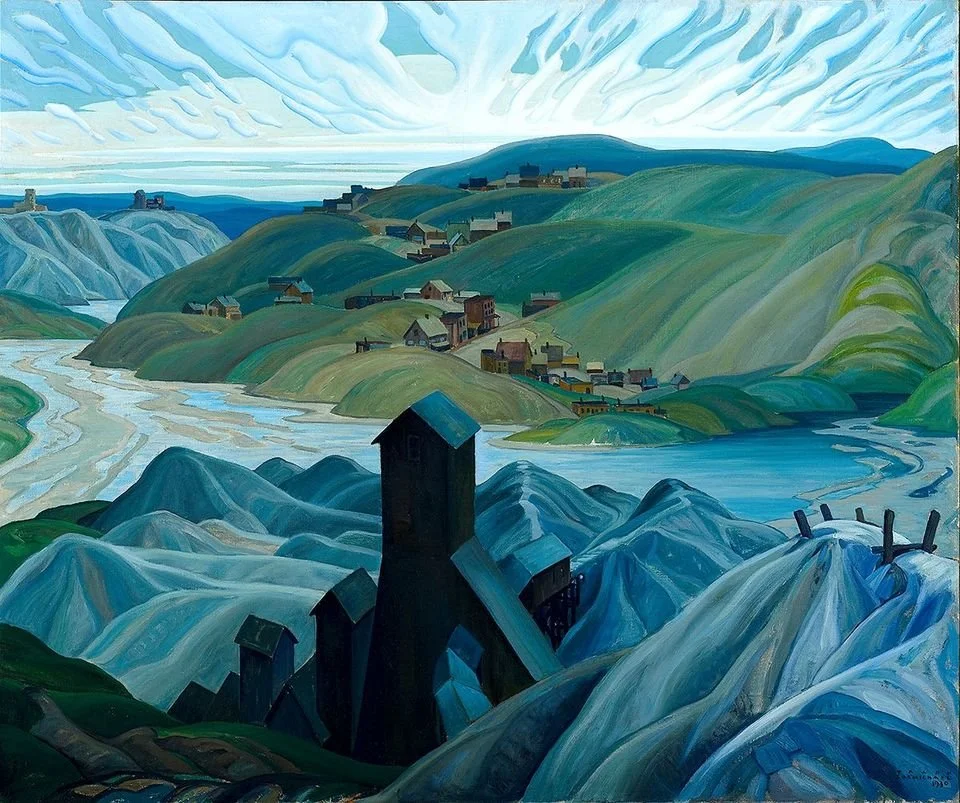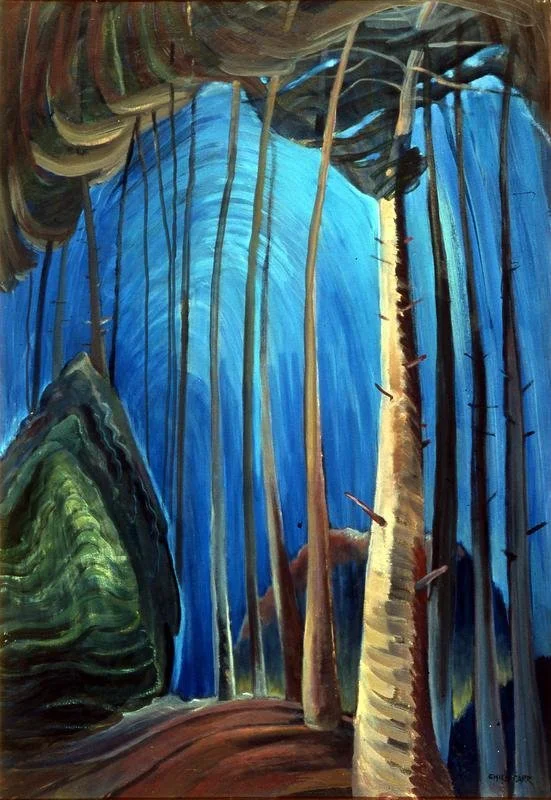The Group of Seven
Written for Rethinking Canadian Art 2801 at The University of Winnipeg, December 12th, 2023.
There may never be a Canadian art movement as impactful as the Group of Seven. The first major Canadian art movement, the Group was established in 1920 and disbanded by 1933. The Group of Seven painters captured the beautiful landscapes throughout Canada creating romantic images of the Canadian wilderness. At the time their movement was greatly critiqued by academics, but the general Canadian public adored their work. Among the most frequent components of their collective works are paintings of unseen and untouched Canadian wilderness. They captured in their work the idea adventurous travelers, breaking new roads in the untouched wilds of the West. This paper will explore the values this movement intrenched as well as the lasting impact the group had with the public.
Members of the Group, Arthur Lismer (who mostly worked in education), Lawren Harris, Fredrick Varley, Frank Johnston, Franklin Carmichael, and A.Y. Jackson were at the forefront of capturing the Canadian wilderness at the tip of their brushes. Among their assets as creators was the frequent use of vibrant colours, put on full display in Lawren Harris’ Maligne Lake.
Lawren Harris, Maligne Lake, 1924, GroupofSevenArt.com.
The movement created by the Group of Seven was significantly inspired by the work of Tom Thomson, an artist and avid outdoorsman whose work brought Canadian landscapes to municipal art halls. After his tragic death in 1917 Thomson left a legacy of a great landscape artist. As is seen in Thompsons piece Old Lumber Dam, Algonquin Park, the silence and serenity of the wilderness was expressed in the deep tones shading the trees and waters around Thompsons canoe near the dock.
Tom Thomson, Old Lumber Dam, Algonquin Park, 1912, National Art Gallery of Canada.
The Group captured in their works the untouched rugged wilderness. Among their key priorities was to step away from outdated European artistic styles. The Group of Seven ushered in a new era of art wherein the artists in the Group worked in and engaged with the Canadian wilderness. There work was simple to comprehend and easy to appreciate as there was no aura of artistic elitism in their paintings.
The Group saw the elite world of contemporary art as having ostracised the general public. Art movements in Canada until then had done “little or nothing to foster a true and lasting cultural awareness in Canadian society.” [1] The group created art that spectators could appreciate as uniquely Canadian and to showcase the beauty of their country. While some members of the Group had trained internationally, Canadians had no personal connection to the art movements of Europe. Through all their work the Group created a new generation of Canadian artists bringing a uniquely Canadian perspective to the international scene, creating a freedom from the impression of European movements.
Between 1910 and 1913 the Group of Seven came together and by 1913 there was a clear establishment of a Canadian movement intent on “exploring the spiritual resources of Canada.”[2] With the disruption of the Great War in 1914 the blossoming movement was put on pause as Canada went to war. The death of Thomas Thomson around this time created an even greater sense of despair for a Canadian art movement in its infancy. Through these hardships the artists matured both as men and as artists.
Following the war, the Group of Seven returned to their mission of painting the mountains and great forests of Canada. In autumn of 1919 the artists in the Group came together in Toronto and by Spring of 1920 they officially held their first exhibition.
The nation was primed and patriotic in the shadow of the war and the Group of Seven contributed to this post-war sentiment by showcasing the strength and beauty of Canada. While this was not an explicit priority of the Group the newfound nationalistic pride blossomed among non-academic Canadians.
While the Group was popular among Canadians, art academics greatly disapproved of them. Regardless, the movement grew significantly from 1925 to 1931. In 1931 the Canadian Group of Painters began to formulate. Inspired by the Group of Seven the Canadian Group of Painters was established in 1933, soon after the final exhibition of the Group of Seven. The new movement of Canadian painters was comprised of artists who started in the “heyday of the Seven from 1925 to 1930,”[3] inspired directly by the Group.
The group captured the Canadian wilderness and created a connection between Canadians and modern art. At this time the North and Western regions were fast being appreciated as part of the great new nation and citizens had “come to accept the wilderness as [their] heritage, and have transformed it into the Canadian playground.”[4]
While the academic world held many judgements against the technique of the Group for parting from traditional styles one outlet supported the work of the Group; The Canadian Forum, founded in 1920. The Forum writers were incredible proponents of Canadian independence. The Forum referred to the movement encouraged by the Group of Seven creating “progressive political and social ideas should prevail over the status quo.”[5]
Like the Group, Forum writers felt the values of typical Canadians needed to be offered a connection to art. To this point it was the elites whose voices and styles were seen and heard in art outlets. The Canadian Forum focused on Canada’s development, becoming a strong, independent nation and with that a greater connectivity, which the Group fostered in their work. The Forum touted Canadian success, including on the artistic front with the Group of Seven.
The Group of Seven created a movement of nationalism and Canadian independence in the artistic world. Post war days saw a shift to true Canadian identity. After having fought alongside their allies, Canadians had established pride in their nation like never seen before. The Group was something Canadians could call its own. By painting and displaying the great mountains, rivers and forests, seen in Franklin Carmichael’s A Northern Silver Mine, the movement was able to “create an awareness of the country in Canadian people.”[6]
Franklin Carmichael, A Northern Silver Mine, 1930, GroupofSevenArt.com.
The Canadian Forum was a boisterous supporter of the Group as it aligned with similar intellectual values of creating a Canadian connection to art with the public. The Forum called for more galleries of Canadian art and exhibitions for the Group in other countries.
Extending their movement to invite Canadians into the art scene the Group went out of its way to include female artists who shared their vision. The most notable among them was Emily Carr. As can be seen in Carr’s piece Blue Sky, the same sentiment of a quiet, undisturbed natural landscape was common in her work, especially in the 1930s.
Emily Carr, Blue Sky, 1932, Art Gallery of Greater Victoria.
Despite their efforts to emphasize the Canadian spirit it is important to note the Group of Seven were not political actors. “Their allegiance is not a political one, and their devotion is to the actual soil and rock of the land. They have something of the abandon and the enthusiasm of the early explorers,”[7] one journalist from the era explained after the Groups final exhibition.
It was not initially the intentions of the Group to create a Canadian school of painting and a brand new art movement. They hoped instead to shake off their European inspirations, to set aside the traditional styles taught to them as these methods had become antiquated. Internationally the Group was recognized and applauded at exhibitions, despite disfavour from some academics at home.
It was, after all, their hope to capture the wilds of Canada which few had been brave enough to find. The ideas held at the time of the mysterious and wise First Nations people was reflected in a contemporary article describing their work, stating “it is the old pagan spirit of Indian days that moves the painter and the power, not the stress and strain of twentieth-century cynicism.”[8]
What the Group captured in their work was something which could only be experienced through the work of traveling into mountains and over rivers to be expressed on canvas. Their work captured the vastness of Canada and the adventurous exploration required to find these picturesque locations. These artists were daring as they sought to capture the essence of peaceful mountains and natural beauty in their work, as is unfortunately exemplified with the loss of Tom Thomson who was out on a voyage of painting and fishing when he died. Their great inspiration was the unforgiving land of Canada. In an article written in 1932 members of the Group are described as “men are [who are] robust intellectuals. They exploded studio myths and made the outdoors their workshop. The took to the trail, summer and winter, with paddles or snowshoes.“[9]
Captured best in their work is the spirit of adventure, something seen in droves as new Canadians forced their way into the untrampled west. This, in and of itself, was a feeling Canadians could identify with. For many the West was a land of potential wealth for anyone brave enough to confront its deep forests. These painters experienced these hidden wonders first hand and brought home masterful works of what they supposed no man had bore witness to before.
The Group of Seven made modern art accessible to Canadians. “They seldom expressed interest in artistic theories but constantly trumpeted the ideal of a Canadian art for Canadians, underlying which was a profound belief in the necessity of engaging a large segment of the population in an active relationship of their own making.”[10] The Group of Seven sparked a Canadian art revolution, distinctly and uniquely Canadian.
Notes
[1] John O’Brian, Beyond Wilderness (McGill-Queen’s Press - MQUP, 2007), 101–8.
[2] Prior to 1910, MacDonald, Varley, Lismer, Jackson, Harris and Thompson pursued formal art studies.
[3] John O’Brian, Beyond Wilderness (McGill-Queen’s Press - MQUP, 2007), 101–8.
[4] Margaret Davidson, “A New Approach to the Group of Seven,” Journal of Canadian Studies 4, no. 4 (November 4, 1969): 9–16
[5] Margaret Davidson, “A New Approach to the Group of Seven,” Journal of Canadian Studies 4, no. 4 (November 4, 1969): 9–16
[6] Margaret Davidson, “A New Approach to the Group of Seven,” Journal of Canadian Studies 4, no. 4 (November 4, 1969): 9–16
[7] Blodwen Davis, “The Canadian Group of Seven,” The American Magazine of Art 25, no. 1 (July 1932): 13–22
[8] Blodwen Davis, “The Canadian Group of Seven,” The American Magazine of Art 25, no. 1 (July 1932): 13–22
[9] Blodwen Davis, “The Canadian Group of Seven,” The American Magazine of Art 25, no. 1 (July 1932): 13–22
[10] John O’Brian, Beyond Wilderness (McGill-Queen’s Press - MQUP, 2007), 101–8.
Bibliography
The Canadian Encyclopedia. “A. Y. Jackson,” n.d. https://www.thecanadianencyclopedia.ca/en/article/ay-jackson.
Alan Klinkhoff Gallery | Art Dealers & Appraisers. “Featured Painting: Lawren Harris Maligne Lake, Jasper Park, 1924,” n.d. https://www.klinkhoff.ca/blog/7896/.
Art Canada Institute - Institut de l’art canadien. “Tom Thomson,” n.d. https://www.aci-iac.ca/art-books/tom-thomson/biography/.
Davidson, Margaret. “A New Approach to the Group of Seven.” Journal of Canadian Studies 4, no. 4 (November 4, 1969): 9–16. https://muse-jhu-edu.uwinnipeg.idm.oclc.org/pub/50/article/675989/pdf.
Davis, Blodwen. “The Canadian Group of Seven.” The American Magazine of Art 25, no. 1 (July 1932): 13–22. https://www.jstor.org/stable/23935372?casa_token=ldNvV9fS4-kAAAAA%3AG6imWUeXcXwuq-6hwO-DcMtzCCZmcSat3r7C5PFEPDnw7ObgrZOfzmt3MYN6UoxL2mcG5LjwSu65NBl0sh5KrkrxYF7n3sRyWg851ppZed19BP0_how.




